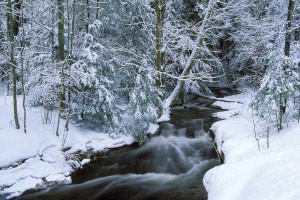The importance of forest cover along streams and rivers is not a new idea – we’ve likely all read that trees stabilize streambanks and prevent erosion, filter out runoff from agriculture and development, and keep water temperatures cool for fish and other aquatic life. “Ecosystem services” is the trendy term to describe the often unrecognized benefits riparian buffer strips provide – benefits such as pollution control, which are not always calculated in the cost of keeping versus cutting a tree. Now scientists have found one more reason for leaving a treed strip of land along waterways: denuded streams become narrower and lose the amount of habitat – the nooks and crannies, if you will – for macroinvertebrates (large stream insects) that process pollutants.
In a study of 16 streams in the eastern U.S., scientists led by Bernard Sweeney of the Stroud Water Research Center in Avondale, Pennsylvania, found that deforestation of streambanks caused narrowing of stream channels as grasses that normally are shaded out by forest cover slowly encroached. The narrower streams resulted in less habitat for stoneflies, caddisflies, mayflies, damselflies, and the like. The forested streams were wider, had slower-flowing water, and had rougher beds than nearby deforested streams. So there would be less habitat suitable for caddisflies in a deforested stream, and the insects would also be more likely to be washed away by the increased velocity of the water.
State and federal governments already endorse the use of buffer strips of trees or grasses to keep pollutants out of streams. Most states in the Northeast suggest that a certain density of standing trees be left within 50 feet of a stream. But what about the pollutants that reach a stream even when a good buffer is left? That’s where the activities of stream-dwelling insect larvae come in. They process the nitrogen and phosphorous that enters streams in fertilizer and pesticide runoff and also absorb chemicals in herbicides and insecticides.
In the forested streams the researchers studied, the insects took up more ammonium over the same length of stream than in deforested streams; also, since the water flowed more slowly through the forested streams, nitrogen and pesticides were in contact with the bottom for a longer time, giving stream insects more opportunities to filter and process them. Insects in forested streams were also able to process much more organic matter than those in deforested streams. In virtually all measures of filtering ability, which directly affects water quality, the macroinvertebrates in forested streams outperformed those in waters with no tree buffers.
But how can riparian forestation be encouraged, since there is no direct financial incentive to maintain good buffers? In a world where clean water is an increasingly scarce commodity, stream insects filtering water that might ultimately be drunk is just one example of an ecosystem service whose value is presently unaccounted for. According to Sweeney, “Perhaps nowhere is that value more evident than in streams and rivers, where hundreds of trillions of tiny organisms work constantly to clean the water.” Perhaps the Poland Springs of the world will be the first to put macroinvertebrates on the balance sheet – and in the process, keep our streams cool, shady, and clean.


